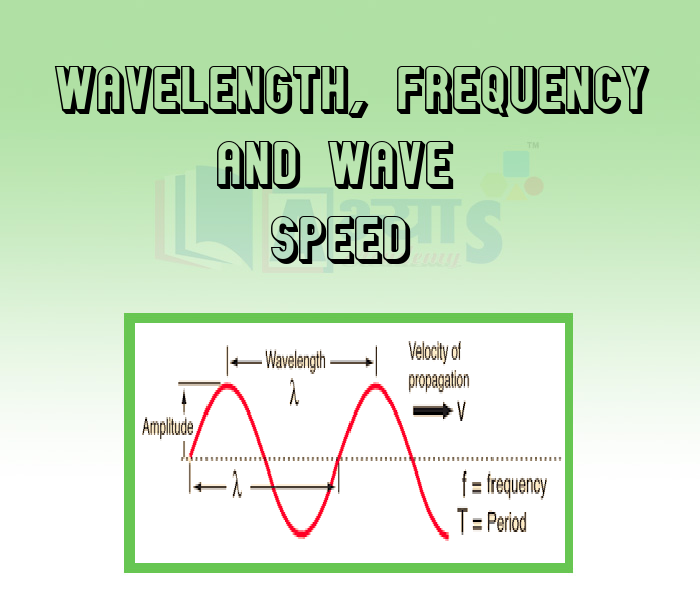Wavelength, Frequency and Wave Speed











Wavelength, Frequency and Wave Speed
Terms to describe sound waves: Sound waves can be described by its
1. Wavelength 2. Frequency 3. Time period 4. Amplitude 5. Speed
Amplitude: The maximum displacement of the particles of the medium from their original mean positions on passing a wave through the medium is called amplitude of the wave. It is used to describe the size of the wave. It is usually denoted by the letter A. Its SI unit is metre. The amplitude of a wave is same as the amplitude of the vibrating body producing the wave.
Wavelength: The distance between the two consecutive compressions (C) or two consecutive rarefactions (R) is called the wavelength. Wavelength is the minimum distance in which a sound wave repeats itself. In other words, it is the combined length of a compression and an adjacent rarefaction. It is represented by a Greek letter lambda ‘λ’. Its SI unit is metre (m).
.jpg)
.png)
Frequency: The number of complete waves (or oscillations) produced in one second is called frequency of the wave. It is the number of vibrations that occur per second. If we can count the number of the compressions or rarefactions that cross us per unit time, we will get the frequency of sound wave. The frequency of a wave is fixed and does not change even when it passes through different substances. It is denoted by ‘ν’ (Greek letter, nu). Its SI unit is hertz (symbol, Hz) named in honour of Heinrich Rudolf Hertz who discovered photoelectric effect.
Time Period: The time taken by two consecutive compressions or rarefactions to cross a fixed point is called the time period of the wave. In other words, the time required to produce one complete wave (or oscillations) is called time period of the Wave. It is denoted by symbol T. Its SI unit is second (s). The time period of a wave is the reciprocal of its frequency,
Speed: The distance travelled by a wave in one second is called speed of the wave or velocity of the wave. Under the same physical conditions, the speed of sound remains same for all frequencies. It is represented by letter v. Its SI unit is metre per second (rn/s). Relationship between speed, frequency and wavelength of a wave:
Which of the following represet periodic motion ? | |||
| Right Option : A | |||
| View Explanation |
| |||||
| Right Option : D | |||||
| View Explanation | |||||
If a wave takes 0.20 seconds to complete one oscillation, how many such oscillations will pass through a fixed point on its path in one second ? | |||
| Right Option : C | |||
| View Explanation | |||
Students / Parents Reviews [10]
Abhyas is a complete education Institute. Here extreme care is taken by teacher with the help of regular exam. Extra classes also conducted by the institute, if the student is weak.

Om Umang
10thMy experience with Abhyas academy is very good. I did not think that my every subject coming here will be so strong. The main thing is that the online tests had made me learn here more things.

Hiya Gupta
8thAbout Abhyas metholodology the teachers are very nice and hardworking toward students.The Centre Head Mrs Anu Sethi is also a brilliant teacher.Abhyas has taught me how to overcome problems and has always taken my doubts and suppoeted me.

Shreya Shrivastava
8thI have spent a wonderful time in Abhyas academy. It has made my reasoning more apt, English more stronger and Maths an interesting subject for me. It has given me a habbit of self studying

Yatharthi Sharma
10thA marvelous experience with Abhyas. I am glad to share that my ward has achieved more than enough at the Ambala ABHYAS centre. Years have passed on and more and more he has gained. May the centre flourish and develop day by day by the grace of God.

Archit Segal
7thMy experience with Abhyas is very good. I have learnt many things here like vedic maths and reasoning also. Teachers here first take our doubts and then there are assignments to verify our weak points.

Shivam Rana
7thAbhyas Methodology is very good. It is based on according to student and each child manages accordingly to its properly. Methodology has improved the abilities of students to shine them in future.

Manish Kumar
10thMy experience was very good with Abhyas academy. I am studying here from 6th class and I am satisfied by its results in my life. I improved a lot here ahead of school syllabus.

Ayan Ghosh
8thIt was good as the experience because as we had come here we had been improved in a such envirnment created here.Extra is taught which is beneficial for future.

Eshan Arora
8thOne of the best institutes to develope a child interest in studies.Provides SST and English knowledge also unlike other institutes. Teachers are co operative and friendly online tests andPPT develope practical knowledge also.

